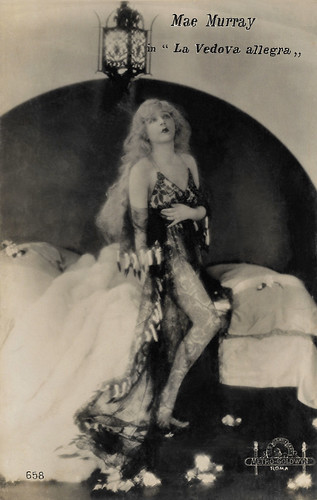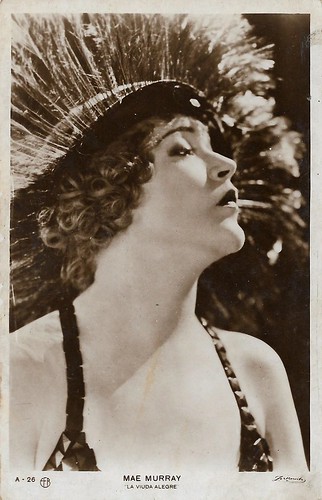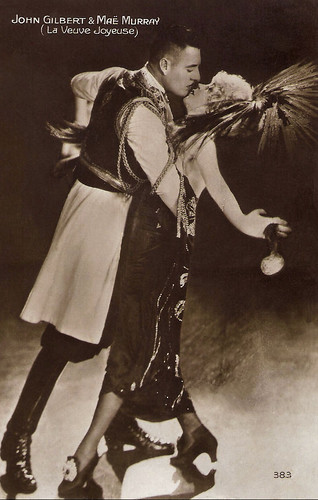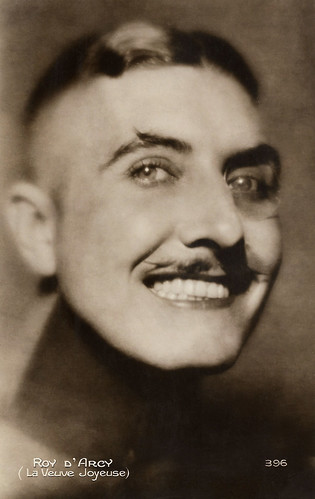
Italian postcard by Casa Editrice Ballerini & Fratini, Firenze, no. 660. Photo: Metro-Goldwyn, Roma. Mae Murray in The Merry Widow (Erich von Stroheim, 1925).

Italian postcard by Casa Editrice Ballerini & Fratini, Firenze, no. 657. Photo: Metro-Goldwyn-Film, Roma. Mae Murray and John Gilbert in The Merry Widow (Erich von Stroheim, 1925).

Italian postcard by Casa Editrice Ballerini & Fratini, Firenze, no. 658. Photo: Metro-Goldwyn, Roma. Mae Murray in The Merry Widow (Erich von Stroheim, 1925).

Italian postcard by G.B. Falci, Milano. Photo: MGM. Mae Murray in The Merry Widow (Erich von Stroheim, 1925).
After a couple of shaky weeks at the box-office, it was a major success
The American silent film The Merry Widow (1925) is a romantic drama/black comedy directed and written by Erich von Stroheim. Next to Mae Murray and John Gilbert, the film also stars Roy D'Arcy as Crown Prince Mirko, and Tully Marshall as Baron Sixtus Sadoja. Joan Crawford and Clark Gable both made uncredited appearances as extras in the film before they became famous.
The Merry Widow is based on the 1905 operetta 'Die lustige Witwe' by Austro-Hungarian composer Franz Lehár. The librettists, Viktor Léon and Leo Stein, based the story – concerning a rich widow, and her countrymen's attempt to keep her money in the principality by finding her the right husband – on an 1861 comedy play, 'L'attaché d'ambassade' (The Embassy Attaché) by Henri Meilhac.
Prince Danilo Petrovich falls in love with dancer Sally O'Hara. His uncle, King Nikita I of Monteblanco, forbids the marriage because she is a commoner. Thinking she has been jilted by her prince, Sally marries the old and lecherous Baron Sadoja, whose wealth has kept the kingdom afloat. When he dies suddenly, Sally must be wooed all over again by Danilo.
The operetta has enjoyed extraordinary international success since its 1905 premiere in Vienna and continues to be frequently revived and recorded. Well-known music from the score includes the 'Vilja Song', 'Da geh' ich zu Maxim' (You'll Find Me at Maxim's), and the 'Merry Widow Waltz'.
'Die Lustige Witwe' was first performed at the Theater an der Wien in Vienna on 30 December 1905, with Mizzi Günther as Hanna, Otto Treumann as Danilo, Siegmund Natzler as Baron Zeta and Annie Wünsch as Valencienne. After a couple of shaky weeks at the box-office, it was a major success, receiving good reviews and running for 483 performances.
The piece became an international sensation, and translations were quickly made into various languages: in 1907, Buenos Aires theatres were playing at least five productions, each in a different language. Productions also swiftly followed in Stockholm, Copenhagen, Milan, Moscow, and Madrid, among other places. It was eventually produced in every city with a theatre industry.
Bernard Grün, in his book 'Gold and Silver: The Life and Times of Franz Lehar', estimates that 'The Merry Widow' was performed about half a million times in its first sixty years. Global sheet music sales and recordings totaled tens of millions of dollars. According to theatre writer John Kenrick, no other play or musical up to the 1960s had enjoyed such international commercial success.

German postcard by Ross Verlag, no. 1319/1, 1927-1928. Photo: Loew Metro Goldwyn. John Gilbert in The Merry Widow (Erich von Stroheim, 1925).

Austrian postcard by Iris Verlag, no. 559. Photo: Metro-Goldwyn-Film. John Gilbert and Mae Murray in The Merry Widow (Erich von Stroheim, 1925).

Spanish postcard by EFB (Editorial Fotografica, Barcelona), no. A-26. Photo: Zerkowitz.
Murray's less-than-merry life as a showgirl and desired object of a baron/fetishist
The first film adaptation of 'Die lustige Witwe' was a Hungarian film, A Víg özvegy/The Merry Widow (1918), directed by Mihály Kertész, who became later known in Hollywood as Michael Curtiz and was one of the most prominent directors during Hollywood's Golden Age. Prince Danilo was played by Mihály Várkonyi, who also worked in Hollywood under the name of Victor Varconi.
Erich von Stroheim's 1925 version was the second film adaptation. The Merry Widow (1925) was shot over twelve weeks with a budget of $592,000. Filming was tense as Mae Murray and director von Stroheim did not get on well. After production, Metro-Goldwyn-Mayer decided it could no longer work with the director after he added sexually explicit scenes and changed the operetta's libretto.
Mordaunt Hall in The New York Times: "The Widow is, of course, impersonated by Mae Murray, who demonstrates true acting ability in this effort. Hitherto she was like a top, and one seldom caught much more than a flash of her face. Here she stands still; she wears her costumes with a full realization of their splendor.
Lucia Bozzola ar AllMovie: "Freely adapting Franz Lehar's Viennese operetta, von Stroheim spent a great deal of screen time on Murray's less-than-merry life as a showgirl and desired object of a baron/fetishist, a lecherous prince, and Gilbert's noble Danilo of "Monteblanco." Through lavishly depicted show numbers, orgies, boudoir assignations, and finally Sally's marriage and swift widowhood by the physically impaired baron, von Stroheim turned The Merry Widow into an examination of the decadence beneath the polished surface of the European nobility. Numerous cuts to feet (over the objections of production head Irving Thalberg) particularly reveal the nature of the baron's fetish; MGM cut a few scenes deemed too racy. Danilo and Sally still unite in the famed "Merry Widow Waltz," allowing love to triumph over sordidness and lead to a grand Technicolor finale."
Upon its release, The Merry Widow (1925) was both a critical and box office success. Critics praised Murray's dramatic skills while also noting that von Stroheim had "made an actress out of Miss Murray". The film made a profit of $758,000.
The Merry Widow was adapted for the screen in sound versions in 1934, 1952, 1962, and 1994. While a print of von Stroheim's silent The Merry Widow (1925) still survives, the end sequence shot in two-tone Technicolor is now lost.

French postcard by Cinémagazine-Edition, Paris, no. 383. Photo: Metro-Goldwyn-Film. John Gilbert and Mae Murray in The Merry Widow (Erich von Stroheim, 1925).

French postcard by Cinémagazine-Edition, Paris, no. 396. Photo: Roy d'Arcy in The Merry Widow (Erich Von Stroheim, 1925).

French postcard by Editions Cinémagazine, no. 478. Photo: MGM. John Gilbert as Prince Danilo in The Merry Widow (Erich von Stroheim, 1925).

French postcard in the Les Vedettes de Cinéma Series, by A.N., Paris, no. 369. Mae Murray [the trema is a mistake] and John Gilbert as the romantic couple Sally O'Hara and Prince Danilo in The Merry Widow (Erich von Stroheim, 1925).
Sources: Lucia Bozzola (AllMovie), Wikipedia and IMDb.
No comments:
Post a Comment